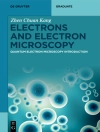Diazonium compounds are employed as a new class of coupling agents to link polymers, biomacromolecules, and other species (e. g. metallic nanoparticles) to the surface of materials. The resulting high performance materials show improved chemical and physical properties and find widespread applications. The advantage of aryl diazonium salts compared to other surface modifiers lies in their ease of preparation, rapid (electro)reduction, large choice of reactive functional groups, and strong aryl-surface covalent bonding.
This unique book summarizes the current knowledge of the surface and interface chemistry of aryl diazonium salts. It covers fundamental aspects of diazonium chemistry together with theoretical calculations of surface-molecule bonding, analytical methods used for the characterization of aryl layers, as well as important applications in the field of electrochemistry, nanotechnology, biosensors, polymer coatings and materials science. Furthermore, information on other surface modifiers (amines, silanes, hydrazines, iodonium salts) is included. This collection of 14 self-contained chapters constitutes a valuable book for Ph D students, academics and industrial researchers working on this hot topic.
Зміст
Preface
ATTACHMENT OF ORGANIC LAYERS TO MATERIALS SURFACES BY REDUCTION OF DIAZONIUM SALTS
A Brief Survey of the Chemistry and Electrochemistry of Diazonium Salts
The Different Methods that Permit Grafting of Diazonium Salts
The Different Substrates, Diazonium Salts, and Solvents that Can Be Used
Evidence for the Presence of a Bond between the Substrate and the Organic Layer
From Monolayers to Multilayers
Structure and Formation of Multilayers
Conclusion
ARYL-SURFACE BONDING: A DENSITY FUNCTIONAL THEORY (DFT) SIMULATION APPROACH
Introduction
Density Functional Theory
Bonding between Aryl and Various Substrates
Summary and Outlook
PATTERNED MOLECULAR LAYERS ON SURFACES
Methods Based on Scanning Probe Lithography
Methods Based on Soft Lithography
Methods Based on Lithography
Methods Based on Surface-Directed Patterning
Summary and Conclusions
ANALYTICAL METHODS FOR THE CHARACTERIZATION OF ARYL LAYERS
Introduction
Scanning Probe Microscopies
UV-VIS Spectroscopy: Transmission, Reflection, and Ellipsometry
IR Spectroscopy
Raman Spectroscopy and Surface-Enhanced Raman Scattering (SERS)
X-ray Photoelectron Spectroscopy (XPS)
X-ray Standing Waves (XSW)
Rutherford Backscattering
Time of Flight Secondary Ion Mass Spectroscopy
Electrochemistry
Contact Angle Measurements
Conclusion
MODIFICATION OF NANO-OBJECTS BY ARYL DIAZONIUM SALTS
Introduction
Electrochemical Modification of Nano-objects by Reduction of Diazonium Salts
Chemical Modification of Nano-objects by Reduction of Diazonium Salts
Summary and Conclusions
POLYMER GRAFTING TO ARYL DIAZONIUM-MODIFIED MATERIALS: METHODS AND APPLICATIONS
Introduction
Methods for Grafting Coupling Agents from Aryl Diazonium Compounds
Grafting Macromolecules to Surfaces through Aryl Layers
Adhesion of Polymers to Surfaces through Aryl Layers
Conclusion
GRAFTING POLYMER FILMS ONTO MATERIAL SURFACES: THE ONE-STEP REDOX PROCESSES
Cathodic Electrografting (CE) in an Organic Medium
Surface Electroinitiated Emulsion Polymerization (SEEP) Chemical Grafting via Chemical Redox Activation (Graftfast/TM)
Summary and Conclusions
ELECTROGRAFTING OF CONDUCTIVE OLIGOMERS AND POLYMERS
Introduction
Conjugated Oligomers and Polymers
Surface Grafting Based on Electroreduction of Diazonium Salts
Polyphenylene and Oligophenylene-Tethered Surface Prepared by the Diazonium Reduction of Aniline or 4-Substituted Aniline
n-Doping and Conductance Switching of Grafted Biphenyl, Terphenyl, Nitro-biphenyl and 4-Nitroazobenzene Mono- and Multilayers
p-Doping and Conductance Switching of Grafted Oligo- Phenylthiophene or Oligothiophene Mono- and Multilayers
p-Doping and Conductance Switching of Grafted Oligoaniline Mono- and Multilayers
Conclusion and Outlook
THE USE OF ARYL DIAZONIUM SALTS IN THE FABRICATION OF BIOSENSORS AND CHEMICAL SENSORS
Introduction
The Important Features of Aryl Diazonium Salts with Regard to Sensing
Sensors and Biosensors Fabricated Using Aryl Diazonium Salts
Conclusions
DIAZONIUM COMPOUNDS IN MOLECULAR ELECTRONICS
Introduction
Fabrication of Molecular Junctions Using Diazonium Reagents Electronic Performance of Diazonium-Derived Molecular Junctions
Summary and Outlook
ELECTRONIC PROPERTIES OF SI SURFACES MODIFIED BY ARYL DIAZONIUM COMPOUNDS
Introduction
Experimental Techniques to Characterize Electronic Properties of Si Surfaces in Solutions
Conclusion and Outlook
NON-DIAZONIUM ORGANIC AND ORGANOMETALLIC COUPLING AGENTS FOR SURFACE MODIFICATION
Amines
Arylhydrazines
Aryltriazenes
Alcohols
Grignard Reagents
Onium Salts
Alkyl Halides
Conclusion
VARIOUS ELECTROCHEMICAL STRATEGIES FOR GRAFTING ELECTRONIC FUNCTIONAL MOLECULES TO SILICON
Introduction
Architecture of Hybrid Devices
Electrografting of Monolayers to Si Negative Differential Resistance Effect in a Monolayer Electrografted Using a Diazonium Complex
Dielectric Monolayers Electrografted Using Silanes
Molecular Diodes Based on C60/Porphyrin-Derivative Bilayers
Memory Effect in TPP-C11 Monolayers Electrografted Using a C=C Linker
Summary
PATENTS AND INDUSTRIAL APPLICATIONS OF ARYL DIAZONIUM SALTS AND OTHER COUPLING AGENTS
Introduction
Patents
Industrial Applications
Conclusion
Про автора
Mohamed M. Chehimi is Research Director at the National Center for Scientific Research (CNRS) in France and the leader of the Surface & Interface research group at ITODYS Laboratory of the University Paris Diderot, where he obtained his Ph D in physical organic chemistry in 1988 and finished his Habilitation in 1995. He has authored over 200 scientific publications and has received the Honorary Medal from the Polymer Institute (Slovak Academy of Sciences, Slovakia) for long term and efficient international cooperation on surface and interface aspects of nanocomposites in 2008. His main research interests are aryl diazonium coupling agents, reactive and functional ultrathin polymer films via surface polymerization or ‘click’ chemistry, carbon/polymer composites for the uptake of heavy metals, molecularly imprinted polymer-based sensors, clay/polymer nanocomposites and films, powders, latex particles, and nanocomposites of conductive polypyrrole.












